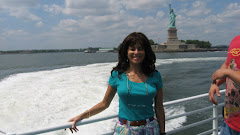3 Days in Vibrant Buenos Aires, Argentina
I spent 3 Days in Buenos Aires after a wonderful 13-day, round- the-horn cruise from Valparaiso, Chile to Buenos Aires.
After waiting for an hour for a taxi from the port, we checked into our Buenos Aires hotel, located in heart of the bustling microcenter.
Day 1 (March 5, 2013)
Our first stop (2:00) was lunch in the nearby modern mall, Galerias Pacifico.
After studying all the maps, I chose a stroll from Plaza San Martin, along Calle Floridato the historical sites around Plaza de Mayo, then a stroll along Diagonal Norte to Plaza de la Republica, and back to our hotel.
First, we strolled along the famous Florida Avenue lined wall-to-wall with shops and restaurants. We were startled to hear (repeatedly) men announcing in a half-whisper: “Cambio”. We learned they were black market currency exchangers. The local newspaper actually posts both the official and unofficial rates of 5.2 and 7.8 pesos to the U$, respectively. It wasn’t until the following day that we decided to conduct business with them upon the advice of our tour guide. Plaza San Martin is a grand park patterned after such parks in Paris, beautifully lined with trees, statues of military heroes, and comfortable esplanades.

After a nice 1 mile walk, we arrived at Plaza de Mayo, lined with palm trees, monuments, fountains, and benches; it is the political heart of the city. Here you find Casa Rosada (A real pink mansion) where the President works, the Metropolitan Cathedral, and other prominent structures pertinent to Argentina’s colonial and 19-20th century’s history. At night, La Casa Rosada is illuminated in raging neon pink!
Next we headed to the grand Avenue of July 9 (9 de Julio Avenue) to see the Obelisk up close and personal. This is considered to be the widest street in the world measuring eighteen lanes wide, (9 in each direction) with gardened medians between the opposing flow of traffic. Only those with a quick pace and long legs will be lucky to get to the other side before the traffic lights at the intersection changes.
The imposing Obelisk, built in 1936 to celebrate the 400th anniversary of the city’s founding, is a focal point for large sports and political celebrations. On December 1, 2005, the obelisk was covered by a giant pink condom to commemorate World AIDS day. It was so well received that it wore the pink condom for the rest of the week! You can see the towering monument from both ends of 9 de Julio Avenue.
While there, we had the good fortune to observe a military ritual of soldiers lowering and removing the flag.
After the feat of crossing this massive street, we relaxed and had coffee in a café.
We strolled along the bustling Avenue Corrientes and small side streets to return to our hotel.
Day 2 (March 6, 2013)
We met our tour guide, Martin, of BA Walking Tours, near our hotel for our 2-hour walking tour of Retiro to Recoleta. Martin is a Buenos Aires native, raised in Canada, who recently returned home to co-manage his family’s tour business. He conducts walking tours daily, rain or shine.
We learned a lot as we visited Plaza San Martin, Alvear Palace Hotel, Arroyo St., the site of the former (bombed in 1992) Israeli Embassy*, the Basilica del Santísimo Sacramento (Holy Sacrament Basilica), Palacio San Martin, Santa Fe St. in Barrio Norte, and ended up in the city’s most exclusive neighborhood, La Recoleta.
Martin held our interest with intriguing stories of Buenos Aires’ past and present. He provides an interesting cross-cultural perspective. I recommend his tours: http://www.ba-walking-tours.com.
We had lunch across from the famous Recoleta Cemetery at the delightful Café Victoria.
 No visit to Buenos Aires is complete without a visit to the Recoleta Cemetery, the most famous cemetery in the world (behind Paris’ Pere Lachaise) a place that pays tribute to Argentina’s historical and elite figures. Ironically, although she was shunned by the elite, Eva Duarte’s (Evita’s) family mausoleum holding her tomb, is by far the most popular site—with long lines of visitors and heaped with flowers and letters from adoring fans. The entire cemetery is laid out in sections like city blocks, with wide tree-lined main walkways branching into sidewalks filled with mausoleums. Most of the 6400+ tombs and mausoleums (small marble and granite houses) are jaw-dropping, no-expense spared, spectacles designed by renowned local and international sculptures. Most materials used between 1880 and 1930 in the construction of tombs were imported from Paris and Milan The architectural variety of the tombs is extensive and includes art nouveau, gothic, neoclassical, Greek temples, pyramids, larger than life sculptures, and more. It is truly a marvel!
No visit to Buenos Aires is complete without a visit to the Recoleta Cemetery, the most famous cemetery in the world (behind Paris’ Pere Lachaise) a place that pays tribute to Argentina’s historical and elite figures. Ironically, although she was shunned by the elite, Eva Duarte’s (Evita’s) family mausoleum holding her tomb, is by far the most popular site—with long lines of visitors and heaped with flowers and letters from adoring fans. The entire cemetery is laid out in sections like city blocks, with wide tree-lined main walkways branching into sidewalks filled with mausoleums. Most of the 6400+ tombs and mausoleums (small marble and granite houses) are jaw-dropping, no-expense spared, spectacles designed by renowned local and international sculptures. Most materials used between 1880 and 1930 in the construction of tombs were imported from Paris and Milan The architectural variety of the tombs is extensive and includes art nouveau, gothic, neoclassical, Greek temples, pyramids, larger than life sculptures, and more. It is truly a marvel!
 |
| Evita's Mausoleum |
Next stop was La Boca (via taxi), the brightly colored, pedestrian only area that is a virtual outdoor museum as well as a marketplace. Surrounding the cobblestone streets are shabby metal houses painted in bold shades of red, yellow, blue, and green where artists live and own galleries. Along the Caminito, art and souvenir vendors work side by side with tango performers. Many restaurants hire a tango dancing couple who perform for all passers-by to enjoy. I certainly enjoyed watching. The murals, sculptures, and engravings, some with political and social themes are an amateur photographer’s delight. The energy was fun and electric, (despite the number of tourists who flock here). I almost returned the next day to soak in the bountiful energy!







Our evening plan consisted of dinner and a traditional live performance of Tango music and dance in an intimate setting at El Viejo Almacen (a landmark built in 1798) in San Telmo. The dancing was excellent, the orchestra superb, and the folk musicians were entertaining. The outing included pick up and drop off from our hotel. Although we were given seats where a post blocked much of our view, we stood in the back where we saw the entire performance without obstruction. They served champagne and all other “complimentary” beverages throughout the show.
After checking out of our hotel room and storing our luggage, we headed to Calle Florida for one more “non-traditional money exchange”transaction. We saved more than $60 off our hotel bill.
Then, we headed to San Telmo via the Buenos Aires subway. We were required to take trains on lines B and C to Indepencia. From there we took a robust walk to the heart of San Telmo. Our first stop was lunch at La Brigada, recommended in my guidebook. The grilled chicken breast we ordered was so difficult to navigate and eat that I am convinced it was not chicken. I joke today that man is one of penguins’ worst threats! ARGH!
Next we headed along Defensa to Plaza Dorrego, the oldest square in the city, alive with musicians, tango dancers, antique dealers, and cafes. We strolled around this Bohemian, newly gentrified area for a bit but needed to taxi back to the hotel to meet our 5PM hired car for the hour-long airport journey.
Some Observations:
Fast paced microcenter
They accept (prefer) U$ although it is illegal for many businesses to accept them
Beef is everywhere—big, red, and tough to chew
Theft against tourists is so common that residents approached us several times to warn us to be on guard.
I learned about Great Britain’s role in shaping Argentina: The British empire is responsible for building most of Argentina’s infrastructure, including railroads, textiles, imported cattle, and utilities, making Buenos Aires a world class city in the 1800s.
Parisian civil engineers and architects designed the city which is why it resembles Paris and is called "the Paris of South America".
Most Argentinians are of Italian ethnicity.
Our tour guide says Porteῆos (BA residents) are Italians, who speak Spanish, who think they are British, who live in Paris!
There is a variety of neighborhoods from posh tree-lined sections to run-down, blighted areas.
On my next trip, I will take a longer tour of San Telmo and visit the Museo Evita.
























































































































.jpg)
.jpg)



